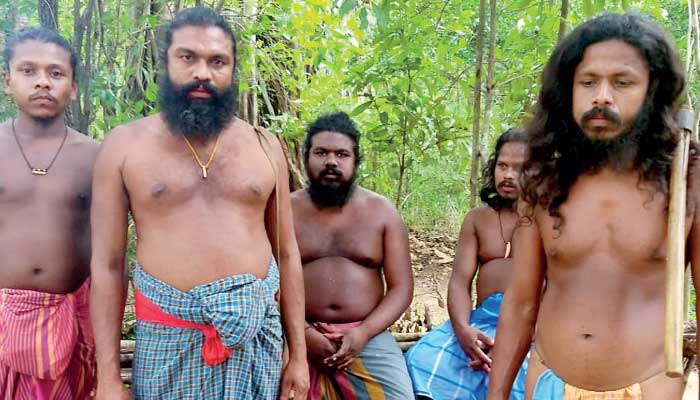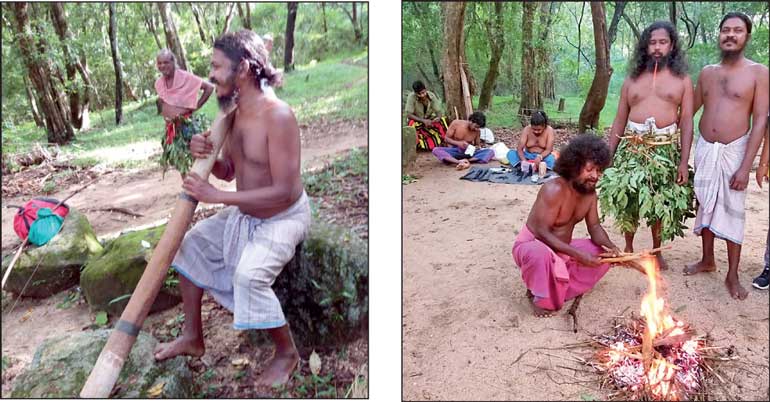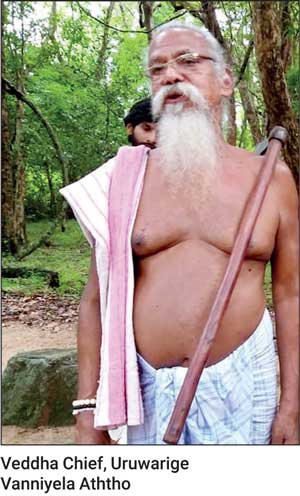Tuesday Apr 15, 2025
Tuesday Apr 15, 2025
Saturday, 23 March 2024 00:10 - - {{hitsCtrl.values.hits}}

Despite the difficulties they face forced by modern man, the Veddha community as a whole exudes a certain calm aura that is like an extension of the forests their bloodline is linked with

 By Surya Vishwa
By Surya Vishwa
This article is a part of a series we started some time back to attempt to analyse why the Aboriginal community of Sri Lanka, known as the Adi Vasis (indigenous/ancient people) and also as the Veddhas or Vannilaye Aththo (people of the Vanni), are important in the present day context in relation to this island in particular and the world in general. We have previously published educative articles on different aboriginal tribes of the world and what they mean in a perishing earth.
We will try to understand why we need to repeatedly awaken to this fact by unravelling some points we may not often think about.
If the term ‘authentic’ or ‘original’ people of the land – i.e. Sri Lanka, could be used (however convoluted such terms maybe) it could be credibly conferred on the Veddha community. They are believed to have the oldest earth-bond to this nation and linked to Quveni the Yakkha tribe queen who married the ousted Indian prince Vijaya.
Interestingly the Veddhas lived through the ethnically identified conflict that destroyed this country for about three decades, from the 1980s to 2009 without taking sides, or being embroiled in any of the hostilities. And they were one segment who never got into dubious debates trying to ascertain which community were the first occupants of the land. Interestingly, the Vanni which is the original geographical location linked with the Veddhas, covers the north of Sri Lanka where the armed conflict for a separate Tamil homeland took place.
Vanniyela Aththo (the Veddha community) is now located mostly in Dambana in Mahiyanganaya (although there are tribes in areas such as Rathugala). Wherever they were, in unison they have remained oblivious to why a war had to be fought in the name of ethnic identity and land demarcation.
To date they do not understand why such a large number of youth had to die for this cause. If this qualifies for ignorance then ignorance equates peace.
An innocence that is not easily found
Their identification with the earth that is the great mother is such they cannot grasp the need to bomb the mother and the children in order to claim her. Thus, the child-like distance of the Veddhas during the bloodiest chapter of Sri Lanka revealed an innocence that is not easily found in the world where human identity is divorced from nature.
Having recognised this above mentioned backdrop let us look at the reality as lived by the Veddhas in Sri Lanka today.
Below is a narration of the Veddha Chief, Uruwarige Vanniyela Aththo in December 2023 when this writer accompanied a group of local and international scholars, musicians and researchers who took part in an international symposium on minority music held in Colombo.
In a manner that spelled both decorum and statesmanship not often seen in many Sri Lankan politicians either in demeanour or deed, he explained the dilemma of his people. His views were expressed in a combination of the Adi Vasi language and Sinhala.
We summarise the crux of what he said;
“We live today imprisoned by a world that does not understand the values which determined our forest based life. To a visitor we seem to be in forested land but this is not how it is. We lived in the depths of the forest which we worshipped and which sustained us. Yet your modern rules and regulations bar us from the forest. If we hunt today as we did then, we are committing an offence and many of our youth have to pay legal penalties. We hunted only when absolutely in need and were bound by stringent ethics. We value life. By and large the forest vegetation fed us. Living in and with the forest we were not at the mercy of anyone for living our life. But how can we live now in your commercialised world? Your world of modernity has gripped us with the hand of poverty and everything which was free we have to now pay for and from where will we earn this cost? Crime occurs due to these reasons and sometimes our youth are called criminals.
“With more rules comes the breaking of it. Our youth, especially our teenagers think your overcrowded concrete cities to be paradise. They want to dress the way they see city people dress and they come to view with contempt that which they were raised on. The vast knowledge we held dear to us taught to us by the greatest teacher the forest is not taught in the schools that our children and youth go to. Many of us are today sick with the modern diseases common to your world. We have many ways of healing but our medicinal knowledge has almost fully died with our elders.
“Who speaks for us? We are invited for diverse functions of the city and then forgotten about. Who hears our voice? Who hears our plight? Who understands that we are forced into a system that cripples us? Who worries how we will earn as your system wants us to earn? We need not have bothered about any of this if a future was created for us taking into consideration the sustaining of all that we held as sacred. We know that not just us, across the globe there are indigenous groups who face the same plight.”
Life threatening diseases which were unheard of for the Veddha community
In January this year this writer again visited the indigenous community in Dambana. This was the occasion of the funeral of a son of the Veddha chief who was in his early fifties. He had died of an ulcer. These are life threatening diseases which were unheard of for the Veddha community a century ago. They lived well into their nineties or surpassing 100 years.
Today many of the children of the Veddha community want to become doctors. Almost every child in Dambana you speak to expresses this wish. When one asks specifically if they are not interested in letting the world know their own medicinal heritage, they stare blankly. The Veddhas have their own forest based medicinal systems akin to Sinhala Wedakama but this knowledge has almost fully died out and is still known only to very few such as the Veddha chief and some of his offspring.
With regard to music, most of the songs that speak of the community the children sing in tunes at times similar to popular songs. A well known musician who works with this community when asked about this phenomena mentioned that it would be impossible to sustain the interest of the children without some ‘modern music influence’ and adaptation. This is true. The children of the community look out at the world as caged birds would. I tried to once tell a group of 10-year-olds that the life they take for granted, whatever the difficulties they face, is far better than the horrific and cramped reality of the city. I stopped after I saw some annoyed looks on the faces of these children. What I interpreted in those glances were; ‘who is this person from the city to tell us to stay on here. As if she knows what we go through…’
Of late one 10-year-old has become a very good friend and keeps updating me everyday about her daily school life and about the shop her mother manages on the side of the road as one turns into the Dambana interior. Her mother sources nature based food from the area such as bees honey. Later in this page we will feature these stories. This woman’s daughter too wants to be a doctor but holding a wisdom far wiser than her years she wishes to be a Western science based doctor while also studying her own indigenous medicinal traditions belonging to her community.
Despite the difficulties they face forced by modern man, the Veddha community as a whole exudes a certain calm aura that is like an extension of the forests their bloodline is
linked with. What is the everyday life of the Veddha community? “Oh they do not live the life they show us. They live in brick houses as we do and perform for us their indigenous dances just for tourism purposes and their interests are commercial.” This is a refrain I have heard from many persons in relation to the Adi Vasi community of Sri Lanka, little comprehending that it is us, the people whose new found deity is modernity who have forced these traits on the Veddha community. We go to see them as if they are some exotic restricted species and often their younger members may even resent having to ‘put on a show’ for the urban and foreign visitors when they are behest with countless burdens.
Veddha community represents the indigenous in us
There is no mechanism to transfer the richness of the culture of the Veddha community onto their youth. The schools the Veddha community’s children go to offer standard education and even the Veddha language is facing the threat of extinction.
When will we realise that the Veddha community represents the indigenous in us?
The safeguarding of the Veddha community is important for the following reasons;
1. To remind us that one cannot eat brick and technological gadgets.
2. To understand that the forests were never threatened by the indigenous people.
3. To understand that the darkness of our souls that have made senseless restrictions for these communities will one day be the pit that swallow us whole.
4. To understand that if we do not at least now safeguard whatever that is left of the richness, dignity and knowledge of the Veddhas of Sri Lanka that this earth will make us pay the price.
5. To understand that much dedication is needed by scholars and researchers to bring public awareness on the policy changes needed for reinstating the rightful indigenous life of the Veddha community.